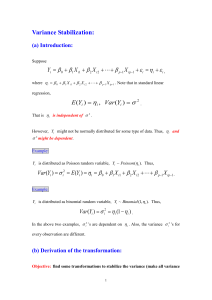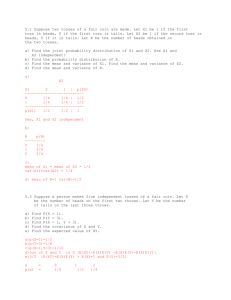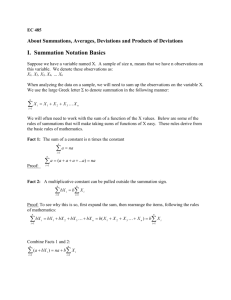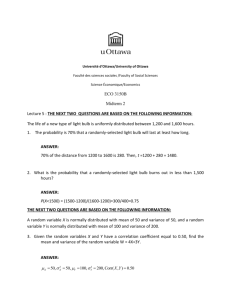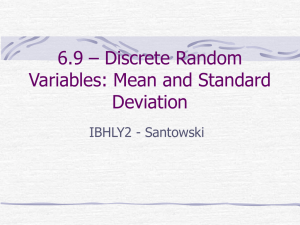Formula Sheet
advertisement
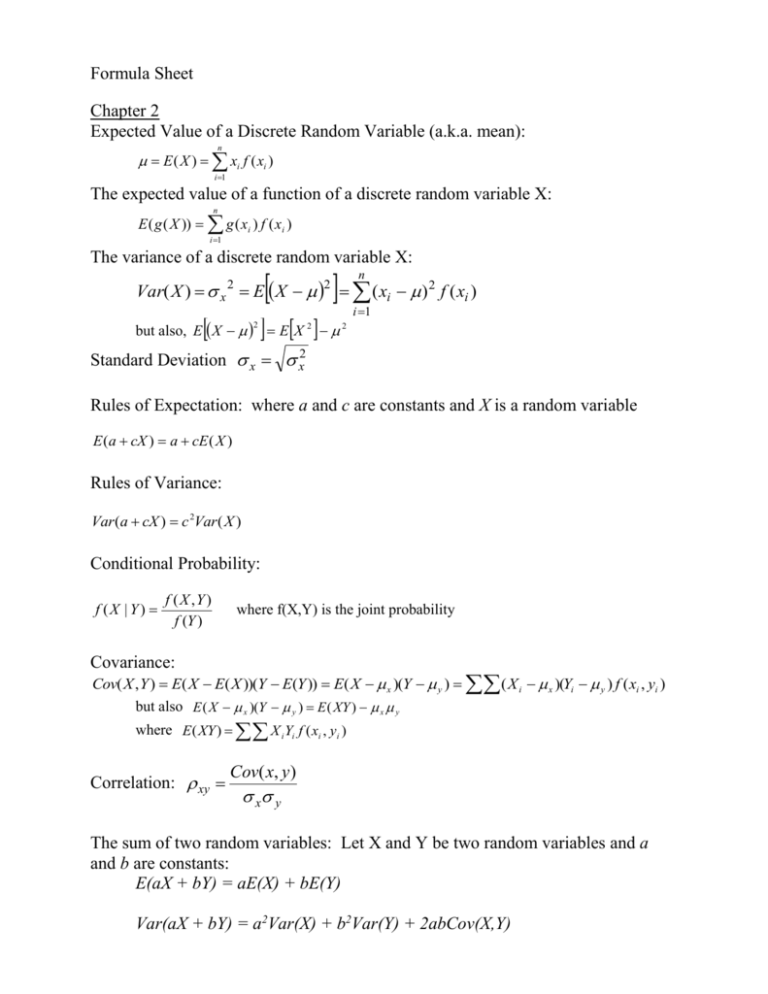
Formula Sheet Chapter 2 Expected Value of a Discrete Random Variable (a.k.a. mean): n E ( X ) xi f ( xi ) i 1 The expected value of a function of a discrete random variable X: n E ( g ( X )) g ( xi ) f ( xi ) i 1 The variance of a discrete random variable X: n Var( X ) x E X ( xi ) 2 f ( xi ) 2 but also, E X E X 2 2 2 i 1 2 Standard Deviation x x2 Rules of Expectation: where a and c are constants and X is a random variable E (a cX ) a cE ( X ) Rules of Variance: Var (a cX ) c 2Var ( X ) Conditional Probability: f (X | Y) f ( X ,Y ) f (Y ) where f(X,Y) is the joint probability Covariance: Cov( X , Y ) E( X E( X ))(Y E(Y )) E( X x )(Y y ) ( X i x )(Yi y ) f ( xi , yi ) but also E ( X x )(Y y ) E ( XY ) x y where E( XY ) X i Yi f ( xi , yi ) Correlation: xy Cov( x, y ) x y The sum of two random variables: Let X and Y be two random variables and a and b are constants: E(aX + bY) = aE(X) + bE(Y) Var(aX + bY) = a2Var(X) + b2Var(Y) + 2abCov(X,Y) Sample Statistics: assume a sample of T observation on Xt T Sample Mean Sample Variance Sample Standard Deviation Sample Covariance Sample Correlation X sx2 Xt t 1 T ( xi x )2 T 1 sx sx2 S xy r 1 ( xt x )( yt y ) T 1 S xy sx2 s 2y ( xt x )( yt y ) ( xt x )2 ( yt y )2 Chapter 3 and 4 Formulas The Method of Least Squares Yt 1 2 X t et , the Least Squares estimator is For the linear model : comprised of the following 2 formulas (where T is the size of the sample): b1 Y b2 X b2 T X t Yt X t Yt T X t2 X t 2 Note that b2 could also be calculated using one of the other 3 formulas: b2 X t X Yt Y 2 X t X b2 X t X Yt 2 X t X b2 wt Yt where wt X t X 2 X t X These estimators have the following means and variances: E (b1 ) 1 and E (b2 ) 2 Var(b1 ) 2 X t2 and Var(b2 ) T X t X 2 2 X t X 2 se(b1 ) Var( where 2 is the variance of the error term and is assumed constant. The estimated line is: Yˆt b1 b2 X t and a residual is eˆt Yt Yˆt The estimator of is ˆ 2 2 eˆt2 T 2 so that se(b1 ) Vaˆr (b1 ) and se(b2 ) Vaˆr (b2 ) where a “hat” means that ˆ 2 has been used in place of 2 in the variance formulas. Chapter 5 and 6 Equations From Section 5.3: The Least squares predictor uses the estimated model to make a prediction at xo. yˆ o b1 b2 xo The estimated variance of the prediction error is: 1 ( xo x )2 vâr( f ) ˆ 1 T ( xt x )2 R-squared is: 2 R2 SSR SSE 1 SST SST where SST ( yt y ) 2 SSE eˆt2 So that R 1 2 eˆt2 ( yt y ) 2 Chapter 7 and 8 For the multiple regression model: ˆ 2 Vaˆr (b2 ) Vaˆr (b3 ) (1 2 r23 ) ( x 2t x 2 ) ˆ yt 1 2 x2t 3 x3t et 2 2 eˆt2 T k 2 2 (1 r23 ) ( x3t x3 ) 2 Adjusted R-squared: F-statistic: F R 1 2 eˆt2 /(T k ) ( yt y )2 /(T 1) ( SSER SSEU ) / J SSEU /(T k ) Let SSER be the sum of squared residuals from the Restricted Model Let SSEU be the sum of squared residuals from the Unrestricted Model. Let J be the number of “restrictions” that are placed on the Unrestricted model in constructing the Restricted model. Let T be the number of observations in the data set. Let k be the number of RHS variables plus one for intercept in the Unrestricted model. Chapter 11 Goldfeld Quandt statistic: ˆ12 SSE1 /(t1 k ) GQ 2 ˆ 2 SSE2 /(t2 k ) This statistic has an F distribution with t1-k degrees of freedom in the numerator and t2-k degrees of freedom in the denominator The variance for b2 when the error term is heteroskedastic is: Var(b2 ) Var( 2 wt et ) wt2Var(et ) wt2 t2 (xt x )2 t2 ( xt x )2 2 White standard errors use this Var(b2) formula, using eˆt2 as an estimate for t2 . Chapter 12 T (eˆt eˆt 1 ) 2 Durbin-Watson test statistic is calculated as: d t 2 T eˆt 2 t 1 2 2 ̂ T and ̂ eˆ eˆ t 2 T t t 1 eˆ t 1 2 t




